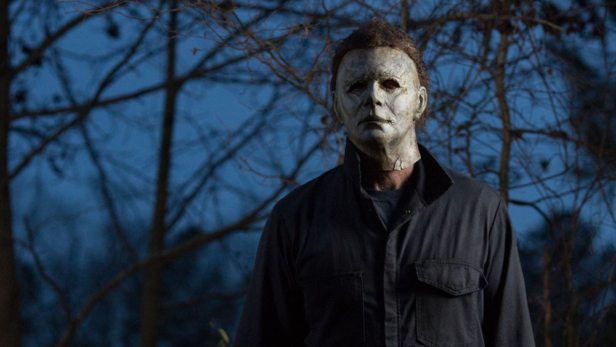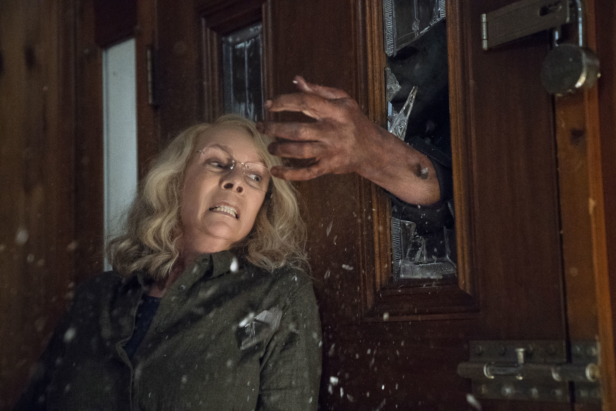That director David Gordon Green, together with screenwriters Danny McBride and Jeff Fradley, opted not to try and outdo the original Halloween was probably a smart decision. Who would even dare do such a thing? An entirely original, completely new take on the story would have been a risky gamble, and bound to disappoint some, even if successful. Their direct sequel to John Carpenter’s masterpiece instead works as an intelligent and often joyfully imaginative homage, clearly written by people versed in Halloween fandom.
Set around Halloween 2018, exactly 40 years after Michael Myers’ rampage through the peaceful Illinois town of Haddonfield, this sequel sees the mysterious murderer once again unleashed and roaming the streets. Like many follow-ups to groundbreaking horror films, this one opts for a comic approach; unlike most such films, however, it thankfully does not get bogged down in needless and confusing backstory. In fact, Green’s film unceremoniously gets rid of the complicated and poor details and revelations about the characters’ pasts that were introduced in the rest of the franchise. The only reference to the nine (!) rejected films is an amusing aside about the rumour that Laurie Strode (Jamie Lee Curtis) would be the killer’s sister.
The film’s comedy indeed largely relies on the viewer’s own impeccable knowledge of the original film. The references are constant and overflowing, but rather than diminishing the genius of Carpenter’s work, they show a complete reverence to it. This is a film made with unwavering love and admiration for every aspect of the original, and although it plays with the conventions of the slasher film in general and the specifics of this one, none of its excellent jokes are at the expense of its basic concept and characters. Green’s film is very entertaining, but doesn’t break a fan’s heart with misplaced derision.
On the contrary, the film’s jokes take root in a profound understanding of the original’s brilliant and revolutionary mechanisms. Looking at an otherwise banal shot in 1978’s Halloween, it would often take a split second to realise that Michael Myers was standing right there, looking straight at us, hidden in plain sight — a brilliant trick that induced nervous laughter and total terror in equal measure. In one delightful moment, Green makes an easy but wonderful reference to it by recreating the shot where Laurie saw Myers through the school window; except this time, Laurie is in his place, and the schoolgirl is her granddaughter.
The film could have gotten away — at the box office at least — with simply copying this visual trick for knowing winks, but Green’s Halloween isn’t a derivative sequel. The new film also brilliantly and earnestly adopts the visual language of Carpenter’s creation. A thrilling sequence has Myers taking advantage of motion sensor lights: he is just standing there, but every time the light comes on, he is closer.
As such, although the jokes are flowing uninterruptedly, the film also feels like a return to the essentials of the Halloween recipe: characters escaping (or failing to escape) from a terrifying, indestructible killer. More precisely, it is Laurie he’s after, and everyone in his way must perish. That our heroine has spent the last four decades preparing herself for the Boogeyman’s return — turning her house into an armory, learning to fight and to shoot with all kinds of weapons — is a fun Sarah Connor moment for international role-model Jamie Lee Curtis. It is also an interesting update on her final girl status from the original film: her intelligence alone (and/or her lack of interest in sexuality) wouldn’t be enough to save her this time. Myers’ victims are more kindly portrayed here than in Carpenter’s film. Although they do cluelessly walk into trouble, they are not stupid, and the film pokes fun at the tropes of the genre rather than at the characters intelligence.
This change however contributes to a greater sense of realism, which places the many extremely graphic murders we witness into a more modern and gory register than that of the original film. Myers’ first murder is the most shockingly cruel of all, setting up the way in which breathtaking violence regularly breaks through the general laid back tone, catching us by surprise. Despite all this good-natured fun, staying alert is recommended.
Though this entry into the franchise sometimes strays into less interesting narrative developments and could benefit from more delicately conceived plotting, it is a heartfelt and imaginative homage to an unparalleled classic.

